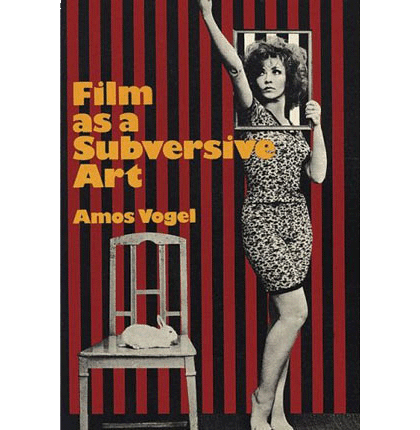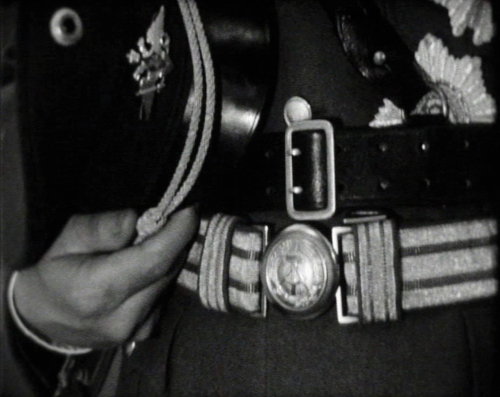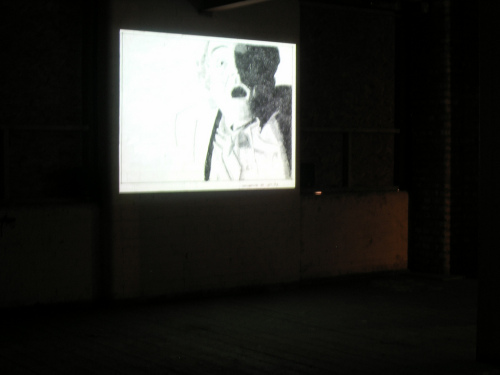Film as a Subservient Art
Untangling a chain of cinematic signifiers and taking Amos Vogel's book as a guide, the Celluloid Liberation Front subverts the Film as a Subversive Art exhibit at Zoo 2009
This film is dedicated to the gallant people of Afghanistan
- Final credits of Rambo III
To go to the cinema is like to eat or shit, it's a physiological act, it's urban guerrilla
- Marco Ferreri
Slavishly prescribing to audiences the mode in which they are expected to consume and perceive cinema, film criticism has often relegated hermeneutical dissections to the academic arena, where the constitutive popularity of cinema is irremediably neglected and spectatorship becomes an analytical datum rather than an emotional factor. Cinematographic criticism essentially opposes what moving images ontologically imply: ‘the inhibition of reasoned response in favour of ‘gut-level' reaction', thus arguing out primaeval subversion in a very liberal fashion via the rationalisation of emotional impulses.1

Image: Cover of Amos Vogel's Film as a Subversive Act (1976)
What a critical text-as-the-work-of-sublimation would ideally aspire to is an ethereal alienation of words from the objective luminescence of images which could liberate the reader from the cathedral shadow of both realms. The word and its signified voltage, through an adumbrating oscillatory movement, would usher the reader into a semiotic alterity that is neither light nor ink but eroticised spect-actorship where the critic's intentions in relation to the luminous object turn into yearning participation. The graphic signifier will offer itself linguistically via outpaced reminiscences as an interpretative contact with cinema without ever letting the normative ghost, resting uneasy behind any form of criticism, deter the destabilising urges of the desiring text.
As a unique example of an encyclopaedic cinema book where films are listed according to evocative themes rather than alphabetical titles, schools or directors and where selection is favoured over saturation, Amos Vogel's Film as a Subversive Art is a fun-da-mental text for insurgent cinephiles and film practitioners alike ‘trafficking in scepticism towards all received wisdom (including its own).'2 Vogel's critical scansion of the cinematic underbelly is one lacking any ideological drive and characterised by a liberated look at the subversive potential of the moving image; concise and delved this book remains an invaluable guide to the affective agency of cinema going. Voluntarily too small to reproduce cinema in its wasted totality but big enough to contain a boundless idea of subversion intended in its emotive terms, galvanising rhythm and universal breadth, Film as a Subversive Art, unlike the Nouvelle Vague ‘angry' critics, did not set a canon and continues to stimulate rather than legislate the viewer's salacious gaze.
The idea of taking such text as the starting point for an exhibition sounds promising and its outcome by no means predetermined, or so one would assume...
Curated by the LUX (in collaboration with students from the Curating Programme of the Department of Art, Goldsmiths), Film as a Subversive Art set out to ‘examine the contemporary possibilities and limits of filmic subversion' during the Zoo Art Fair (16-19 October, 2009), one of the countless pseudo-events self-evidently feeding the obscene ghettoisation of art being adhibited to the docile middle-class infantry.
Desperate for the new, but disappointed with anything but the familiar, we recolonize past and future. The same trend can be seen in public relation, in the way people are expected to package themselves, their emotions and sexuality in attractive and instantly appealing forms.3
The LUX itself historically incarnates the inexorably pusillanimous parable of alternative British cinema, primarily represented by the London Filmmakers Co-operative, whose
principles of (direct) democracy, common ownership and open access [...] annulled themselves into a normalized hierarchical management structure as a condition of the move to the Lux.4
As banal as it may sound, what this project seemed to explore best in those three days of the festival was the limitless impossibility of subverting the ingratiating system of falsity that detracts the means of perception from the cultural consumer who is essentially indifferent to his/her own aseptic environment as long as he/she is false-fed with reassuring guises. The audience – like any targeted indusium, subserviently accepting - are overwhelmingly pacified by appearances and do not enquire any further, let alone try to detonate the (in)sensitive regime of uniformed signs.

Image: Carefully cropped still from Ellen Cantor's Pinochet Porn, 2009
During the opening talk, and after having briefly introduced Vogel's book, the curators exposed the nature of the project, which, instead of proposing a pedestrian sequel of the book in the form of a screenings series that would have probably fitted the original bill, had decided to let artists respond to the book's impulses. It came as a surprise though when, from the audience, someone asked the two artists attending the introductory talk what exactly was the ‘role' the book played in their respective works – was it an inspiration, an influence, a frame of reference? They both quite nonchalantly admitted to having encountered Film as a Subversive Art not long before they were asked to take part in the exhibition (wasn't the latter supposed to be a response to the book?) – one delivering a clueless and lengthy non-reply, the other honestly alleging his work's essential extraneity to Vogel's text. Fair enough – to anti-heroically refuse the auratic heftiness of the ‘holy' book is a subversive act in itself. Or so one would assume... .
On day one, Ellen Cantor's work Pinochet Porn bluntly externalised the tragic incapacity within each and every one of us to push the limits of a communicative potentiality, a feature due to resurface later on, where the form is in fact coldly restrained to the codified areas of linguistic signification. That pornography is the nakedest of acts, where we ineluctably witness the coercive nature of human relations, is not the freshest of ideas but it surely is something one could speculate on. If the exploitative nature of pornography, though, is didactically aggravated by a gross characterisation of the protagonists – the perverted dictator having consensual (shouldn't it be abusive?) sex with his maid trapped between cold execution and repressed degustation – and a horde of predictably empty vignettes, the result will be aesthetically anaemic and poetically embarrassing (not the same embarrassment, I suppose, felt by the giggling spectators at the sight of fellatio...). The artist's explanatory article is filled with barely credible and irrelevant anecdotes. No clue emerges as to why a creative urge was felt and how it was subsequently ‘articulated'; the parallel slide show portraying two women engaging in simulated and repressed mutual auto-eroticisation testifies to the overall aimlessness of this quelled piece.
A sort of ‘conceptual coherence' (the term ‘subversion' would somehow be infelicitous) emerged on day two, with the exhibition by Rosa Barba, consisting of two pieces: the live, devolving 16mm loop demonstration One Way Out and the papyraceous reflections of the Printed Cinema Series. The first installation thought through the deteriorating aspect of the time-image: the film passes through a ventilation machine thus sabotaging the conventional projector stages while visually rendering the progressive impairment of filmic matter, matched by a soundtrack that progressively drones into distortion, accompanying the print's disintegrating fate.

Image: Francisco Valdes' installation Reagan 1973, 2003, at Film as a Subversive Art
The Printed Cinema Series explored, and to some extent expanded, the relational aesthetics of the image measured against a papery base whereby the gregarious nature of the latter is invested in an amplified probing quality engrained in its very materiality. In order to diagnose the dyslexia of montage or to describe the dérives of a drifting Swedish island, the artist found in the porous possibilities of cellulose a platform where the cinematographic image cognises a dialectical dimension freed from the descriptive burden of many auxiliary texts. It is precisely this being a syncretic object, bearer of visions and experiences, not merely a recipient of the content's forms but also of the very substance of expression, that confronts Barba's work with Vogel's book and its (successful) attempt to gatecrash the assertive/descriptive element of written texts. Here the gaze focuses on the medium's possibility of inter-semiotic transpositions, on the fields of signifying tension within the semiosphere, to modulate and organise meaning in the hand-to-hand between film and spectator. Through the narrative design of her own cinema, the artist offers the spectator/reader a third access to an experience in which comprehension is not the disclosing of a given signification. On the contrary, it is a dialectical negotiation based on the manifested datum and its perception. The textual suture between the logics of sense (narrative and figurative) and the logics of the sensitive (plastic and figural) is what makes the Printed Cinema Series a challenging attempt at the mise-en-form of the viewing experience.
Relying on the very process of creative reassemblage rather than pre-projecting a work halfway between a curatorial scheme and art 'n' paste, Disambiguation by Steve Reinke & James Richards ends up feeling like an important and programmatic declaration of non-intent. The semantic internment of this work seems to be a consequence, rather than the lucid exploration of, the English state of expressive constipation. If the aim was to render explicit the creative void behind much of today's art and the directionless drives animating its profit-making and sense-emptying logics, then yes, Disambiguation makes its point painfully visible. If though, as the context would suggest, this was even the faintest attempt at subversion, then I am left wondering what the subject matter was. To derive the insipid assimilation ‘anti-narrative equals non-narrative', to bypass the attack on dominant signification, thus opting for desperate masturbation instead of the reciprocal joy of a meaningful orgy, seemed to gratify the privileged arty punters blankly staring at an uncommunicative cascade of found footage.
The last day was dedicated to the apocryphal resurrection of repressed historical occurrences and their co-inspirational coincidences with Francisco Valdes' Reagan 1973, exploring the purified arrogance of the US against its pagan enemies. Valdes observes the disquieting concurrence of the release of Friedkin's The Exorcist and the brutal invasion of Chile. He loops the graphite reproduction of a film's sequence in order to go beyond its deceiving surface. Like Hemming's character in Blow Up, the spectator is invited to produce thoughts able to ripple the perfunctory appearance of the image thus questioning its apparent truth. Unlike its glorious predecessor, The Exorciccio, by Ciccio Ingrassia – a para-situationist parody of the Hollywood movie – this interesting work is nonetheless highly cryptic to the ‘non-initiated'. In the Italian flick – in a quasi-Herzogian resurgence – evil is strategically anathematiseable. Its (il)logics beyond rationality and, most importantly, beyond the purifying will of the Exorciccio who will finally succumb to the malign magnitude of the devil after having replaced the Bible with Chairman Mao's Little Red Book. The pranksterist impression left by Ingrassia on Reagan 1973's also evokes a philosophical intuition that has partly predated Abel Ferrara's psycho-carnal reflections about western dependence on atrocious exhibitions, and manages to subvert ruling narratives through a mutual illumination of cinematic detonations.
In an era where the work of art is socially neutralised via its anti-perceptual insularity, dynamitesthetic ecstasy remains a lethal weapon against the occult persuasion of mass media but its ontological incompatibility with vocationally gated events and their institutionalised codas is perhaps something we need to face.
Celluloid Liberation Front <celluloidliberationfront AT gmail.com> is a multi-use(r) name, an ‘open reputation' informally adopted and shared by a desiring multitude of insurgent cinephiles, transmedial terrorists, aesthetic dynamyters and random deviants. For reasons that remain unknown, the name was borrowed from a collective of anti-imperialist blind filmmakers from the Cayman Islands whose films have rarely been unseen. Visit, http://www.celluloidliberationfront.blogspot.com
This article is protected at the request of the author under the Creative Commons Attribution-non Commercial 2.0 UK: England and Wales.
Info
Film As A Subversive Art, curated by LUX, was screened at the Zoo Art Fair, London, 16 - 19 October, 2009,
http://www.lux.org.uk/news/lux-exhibition-zoo-art-fair
Footnotes
1 Amos Vogel, Film as a Subversive Art, London: C.T. EDITIONS, 2005, p. 9.
2 Ibid..
3 JG Ballard, The Atrocity Exhibition, London: Flamingo, 2001, p. 88.
4 Duncan Reekie, Subversion, London: Wallflower Press, 2007, p. 156.
Mute Books Orders
For Mute Books distribution contact Anagram Books
contact@anagrambooks.com
For online purchases visit anagrambooks.com






